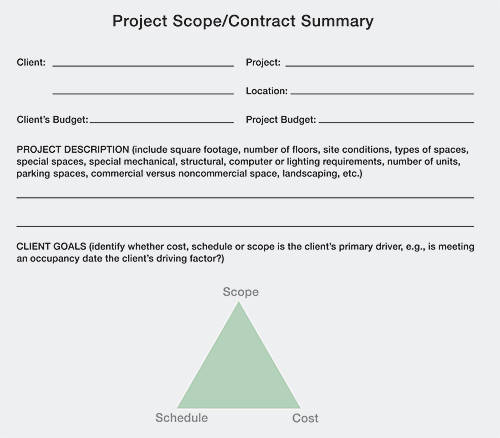Managing Client Expectations to Reduce Professional Liability Risk
|
"Design firms run into trouble when they include broad, general language in their scope of services provisions," Rabasca warns. "For example, by writing in the contract the phrase, ‘providing any and all engineering services necessary,' or ‘providing complete architectural services,' the designer makes a sweeping and open-ended offer. The scope is not clearly defined."
Without a clearly defined scope, a design firm might find it difficult to charge for what its principals consider to be additional services. Given the nature of design projects fraught with changing conditions, codes, regulations, construction limitations, etc., additional services are often needed. If you provide them, you certainly should be paid for them.
"We always advise our insureds to make a specific determination of what services the firm will - and will not - provide and specify them in the project contract's scope of services," Lewis says. "If this is not done and the firm decides to bill for what it considers to be additional services, it may be in for a surprise when the client, or client's lawyer, disputes such charges."
To get an idea of just how effective a clearly defined scope of services can be, consider the following situation:
An engineering firm provided services to a city that was repairing its sewer collection system. As part of its services, the firm agreed to provide a resident project representative (RPR), who would be responsible for construction administration and construction observation services. During construction, a contractor failed to properly dispose of material containing asbestos, which led to major problems with the project. Fortunately for the engineering firm, the contract read that neither the RPR nor the firm was required (or permitted) to "supervise, direct or have control over Contractor's work." Further, the RPR had no "authority over or responsibility for the means and methods, techniques, sequences or procedures selected by Contractor."
|
Though the city included all parties in its ensuing claim, it never charged negligence on the engineering firm's part. A settlement was reached in which the firm's only obligation was to provide a limited amount of in-kind services on a future project. However, had there been a less specific scope of services, or none at all, the engineering firm could have been on the hook for a lot of money.
Managing Client Expectations as Firm Protocol
As you move from client to client and project to project, each situation will present its own special set of challenges. Your ability to successfully meet these challenges and manage your clients' expectations will be greatly enhanced if your firm has a set of internal procedures it follows without fail. If you haven't already instituted the procedures below, consider starting.
- Project-Specific Measures
Since, presumably, you've worked hard to include a thoroughly considered, well-crafted scope of services in your project contract, it's important to communicate it to the entire project team, and to constantly re-visit it as the project progresses. Rabasca suggests that A/E firms "institutionalize" internal communications to confirm project team members' understanding of the exact extent of services required on a project. "The scope and its status should be addressed at every internal meeting," he says. "This needs to be a priority action item on every internal meeting agenda in order to keep it ‘top of mind' for all project team managers and members."
Absent such consistent emphasis, members of the project team, caught up in the day-to-day details of the project, can easily find themselves performing tasks not included in the agreed-upon scope of services.
In addition to making the scope of services review part of every meeting agenda, Lewis suggests a handy way to keep scope in the spotlight.
"One surprisingly simple yet powerful tool we recommend is a project scope and contract summary," he says. "It's a concise form covering many aspects of the project and contract that will help keep project team members on the same page." The summary lists basic project and client information, the client's budget and the client's highest priority: cost, schedule, or scope.
|
"The project scope and contract summary should serve as a touchstone throughout the course of the project," Lewis adds. "Members of the design team, and all client parties, should frequently refer to the document during each phase of the project."










